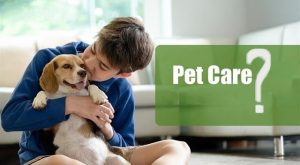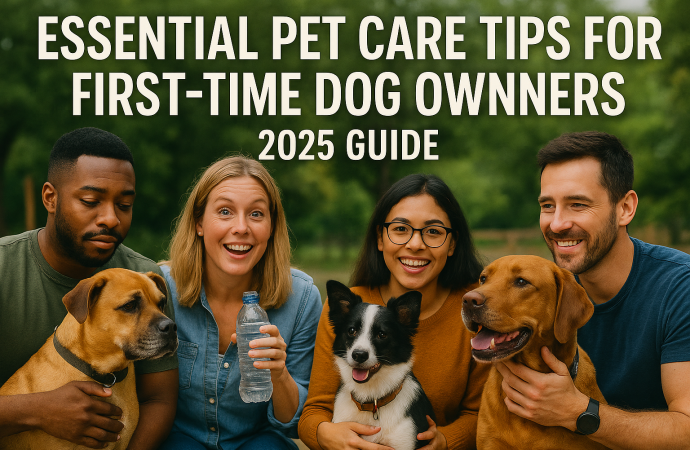Introduction Bringing home your first dog is exciting but also a big responsibility. As a first-time dog pet owners, you need to learn the ropes quickly. Good essential pet care sets the stage for a happy, healthy bond that lasts years. This dog care guide 2025 will walk you through everything: from preparing your home,
Introduction
Bringing home your first dog is exciting but also a big responsibility. As a first-time dog pet owners, you need to learn the ropes quickly. Good essential pet care sets the stage for a happy, healthy bond that lasts years. This dog care guide 2025 will walk you through everything: from preparing your home, to puppy training basics, to choosing the right food, and keeping up with vet visits. You’ll also learn simple canine behavior tips to understand your dog’s needs. By the end, you’ll have clear, actionable advice to give your new furry friend the best start in life. Let’s dive in!
What Is Essential Pet Care for First-Time Dog Owners?

Image by: Yandex.com
Essential pet care covers all the basics your dog needs to thrive. It includes a safe home, balanced diet, regular exercise, grooming, training, and health checks. Think of your dog as a family member who relies on you for food, water, and affection. As a first-time dog owner, you’ll juggle many tasks. A clear dog care guide 2025 helps you stay on track. You’ll learn how to set routines for meals, playtime, and rest. You’ll also discover the supplies you need—collar, leash, crate, and toys. With essential pet care in place, you’ll reduce stress for both you and your pup, creating a smooth transition into life together.
Top Essential Pet Care Tips for First-Time Dog Owners 2025

Image by: Yandex.com
1. Preparing Your Home for Your New Dog
Before your dog arrives, make your home safe and welcoming. Remove any toxic plants, secure trash cans, and block off small spaces where your pup could get stuck. Set up a cozy crate or bed in a quiet corner. Fill it with soft blankets and a favorite toy. Place food and water bowls nearby.
Stock up on supplies: a sturdy collar with ID tag, a leash, puppy pads, waste bags, and chew toys to ease teething. Puppy-proof cabinets and hide electrical cords. Keep cleaning supplies on hand for accidents.
Introduce family members to basic rules—who feeds and walks the dog, and where the pup is allowed to roam. A calm, organized home helps your new dog feel safe. By planning ahead, you avoid surprises and help your dog settle in quickly.
2. Puppy Training Basics and Socialization
As a pet parent, training starts on day one. Use positive reinforcement praise and treats to reward good behavior. Teach your puppy to begin with simple commands like “sit,” “stay,” and “come.” Practice in short training sessions of five to ten minutes to hold your pup’s attention.
Socialization is equally vital. Expose your dog to new people, sounds, and environments in a safe way. Arrange playdates with vaccinated puppies. Training your puppy to take short walks around the neighborhood. Introduce your pup to car rides, vacuum cleaners, and friendly strangers. These early experiences shape confident, well-adjusted dogs.
Consistency is key. Everyone in your household should use the same commands and rewards. Avoid punishing mistakes—instead, redirect unwanted behavior gently. With patience and practice, your dog will learn quickly.
3. Nutrition and Feeding Schedule
Good dog nutrition advice fuels growth and energy. Puppies need food formulated for growth, while adult dogs require maintenance formulas. Choose high-quality kibble or wet food with real meat as the first ingredient. Avoid fillers like corn and soy.
Feed your dog at set times: twice a day for adults, three to four times for puppies. Measure portions based on the package guidelines and adjust for activity level and body condition. Monitor your dog’s weight and coat health.
Provide fresh water at all times. Clean bowls daily. For picky eaters, rotate protein sources—chicken one day, fish the next. Slow-feed bowls or puzzle feeders can prevent gulping and add mental enrichment.
Consult your vet for special diets if your dog has allergies or health conditions. Proper nutrition supports strong bones, shiny fur, and a robust immune system.
4. Grooming for Dogs: Keeping Your Pup Clean and Healthy
Regular grooming for dogs keeps your pet clean and spot health issues early. Brush your dog’s coat weekly to remove loose fur and prevent matting. Short-haired breeds need less frequent brushing, while long-haired breeds may require daily care.
Bathe your dog every one to three months using a gentle, dog-safe shampoo. Overbathing can strip natural oils, causing dry skin. Trim nails every two to three weeks to avoid painful overgrowth. If you hear clicking on the floor, it’s time for a trim.
Clean ears monthly with a vet-approved solution to prevent infections. Wipe around the eyes to remove discharge. Brush teeth several times a week with dog toothpaste to prevent dental disease.
Professional grooming every few months can help with nail care, nail trims. coat trims, and deep cleaning. A clean dog is a happy dog.
5. Dog Health Checklist: Vet Visits and Vaccinations
Regular vet visits are crucial to your dog’s health. Puppies need vaccinations at six, eight, and twelve weeks. Core vaccines include rabies, distemper, parvovirus, and adenovirus. Your vet may also recommend non-core vaccines based on lifestyle.
Schedule annual veterinary care checkups for adult dogs. Senior dogs may need exams every six months. Use these visits to discuss diet, behavior, and preventive care. Regular blood work and dental care checks catch health problems early.
Prevent parasites with year-round flea, tick, and heartworm preventives. Choose vet-approved products and follow dosage instructions. Keep a record of all treatments and vaccinations.
A solid dog overall health health checklist gives you peace of mind and keeps your dog in top shape.
6. Canine Behavior Tips for a Strong Bond
Understanding canine behavior tips helps you build trust. Dogs communicate with body language—tail wags, ear positions, and posture. A relaxed dog has a loose stance and soft eyes. A fearful dog may cower or tuck its tail.
Reward calm behavior with treats and praise. If your dog jumps up or barks for attention, turn away until it calms down. This teaches polite manners. Use a consistent command like “off” and reward when all four paws touch the ground.
Create routines for feeding, play, and rest. Dogs thrive on predictability. A clear schedule reduces stress and helps with potty training.
Spend quiet time together—gentle petting or brushing—to strengthen your bond. A well-understood dog is a confident, loyal companion.
Future of Pet Care in 2025 and Beyond
Image by: Yandex.com
The next wave of pet care uses smart gadgets and online help to make life easier. Wearable trackers for dogs will monitor heart rate, steps taken, and sleep patterns, all sent to your phone. Automated feeders will release measured portions at set times, keeping your dog on a steady diet. Virtual vet visits will let you check on health worries without a trip to the clinic. Training apps will offer video tips and reminders to practice basic commands each day. These tools will help first-time dog owners stay on track and catch health or behavior issues early, ensuring dogs live longer, happier lives.
Comparative Table: Puppy Care Schedule by Age
| Age Range | Meals per Day | Training Focus | Key Care Tasks |
|---|---|---|---|
| 8–12 weeks | 4 | Socialization, potty training | First vaccinations, crate setup |
| 3–6 months | 3 | Basic commands, leash training | Spay/neuter decision, teething support |
| 6–12 months | 2–3 | Advanced commands, off-leash | Adult diet transition, continued socialization |
| 1–2 years | 2 | Reinforce training | Dental check, breed-specific care |
| 3+ years | 1–2 | Maintenance walks, play | Annual vet visits, weight checks |
Conclusion
As a first-time dog owner, mastering essential pet care ensures your dog grows into a happy, healthy adult. Prepare your home, follow puppy training basics, and stick to a balanced feeding and grooming routine. Keep up with daily exercise, mental games, and vet visits using a clear dog health checklist. Learn canine behavior tips to bond and communicate effectively. With consistent care, your new dog will thrive and return your love tenfold.
















